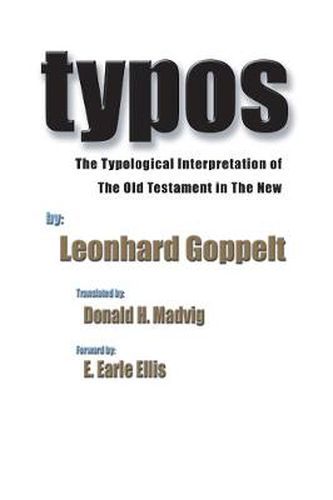Readings Newsletter
Become a Readings Member to make your shopping experience even easier.
Sign in or sign up for free!
You’re not far away from qualifying for FREE standard shipping within Australia
You’ve qualified for FREE standard shipping within Australia
The cart is loading…






This is a print on demand book and is therefore non- returnable. In 1938-39 Leonhard Goppelt finished his doctoral dissertation at Erlangen entitled Typos: Die typologische Deutung des Alten Testaments im Neuen. The lasting value of his work was evidenced in 1969 when this dissertation was reprinted, with an appendix on Apocalypticism and Typology in Paul. Goppelt’s work has maintained its significance because it deals with biblical hermeneutics – the study of the methodology of biblical interpretation – a subject of renewed interest in the last few years.
In his search for a normative hermeneutics, Goppelt appeals to the New Testament’s interpretation of the Old Testament as a guide. He offers a study of the interpretation of Scripture that is characteristic of the New Testament in order to provide a standard guide for interpreting the Bible today. The focal question for Goppelt is how the Old Testament and Jesus Christ are related, and Goppelt’s answer to this question is found in how the New Testament interprets the Old Testament – typologically.
Goppelt begins with a brief survey of the various definitions of typology to determine how it is distinguished from allegory, with which it is often confused. After this introductory chapter, Goppelt divides his work into three parts: Typology in Late Judaism, Typology in the New Testament, and Apocalypticism and Typology in Paul. In his survey of late Judaism, Goppelt examines both Palestinian and Hellenistic Judaism to determine the place of typology in their literatures. Turning to the New Testament, Goppelt looks first at the portrayal of Jesus Christ in the Synoptic Gospels and Acts. Elements of this portrayal are Jesus as the Prophet, as the Son of David and Lord, and as the Son of Man. Goppelt finds each of these characterizations typologically related to the Old Testament. Similarly, in his next chapter on the church as portrayed in the Synoptics and Acts, Goppelt finds a number of typological relationships between the people of God in the Old Testament and the church in the New Testament.
Goppelt next examines the Pauline epistles for Paul’s use of Scripture in general and for his view of Christ and the church. Goppelt here appends brief treatments on 1 and 2 Peter and Jude. In following chapters Goppelt deals with Hebrews, the Gospel of John, and finally apocalypticism and typology in Paul. Here he also examines traditional approaches to the relationship between the Old Testament and the New, the origin and legitimacy of the typological approach, and the relationship between typology and the historical-critical method.
$9.00 standard shipping within Australia
FREE standard shipping within Australia for orders over $100.00
Express & International shipping calculated at checkout
This is a print on demand book and is therefore non- returnable. In 1938-39 Leonhard Goppelt finished his doctoral dissertation at Erlangen entitled Typos: Die typologische Deutung des Alten Testaments im Neuen. The lasting value of his work was evidenced in 1969 when this dissertation was reprinted, with an appendix on Apocalypticism and Typology in Paul. Goppelt’s work has maintained its significance because it deals with biblical hermeneutics – the study of the methodology of biblical interpretation – a subject of renewed interest in the last few years.
In his search for a normative hermeneutics, Goppelt appeals to the New Testament’s interpretation of the Old Testament as a guide. He offers a study of the interpretation of Scripture that is characteristic of the New Testament in order to provide a standard guide for interpreting the Bible today. The focal question for Goppelt is how the Old Testament and Jesus Christ are related, and Goppelt’s answer to this question is found in how the New Testament interprets the Old Testament – typologically.
Goppelt begins with a brief survey of the various definitions of typology to determine how it is distinguished from allegory, with which it is often confused. After this introductory chapter, Goppelt divides his work into three parts: Typology in Late Judaism, Typology in the New Testament, and Apocalypticism and Typology in Paul. In his survey of late Judaism, Goppelt examines both Palestinian and Hellenistic Judaism to determine the place of typology in their literatures. Turning to the New Testament, Goppelt looks first at the portrayal of Jesus Christ in the Synoptic Gospels and Acts. Elements of this portrayal are Jesus as the Prophet, as the Son of David and Lord, and as the Son of Man. Goppelt finds each of these characterizations typologically related to the Old Testament. Similarly, in his next chapter on the church as portrayed in the Synoptics and Acts, Goppelt finds a number of typological relationships between the people of God in the Old Testament and the church in the New Testament.
Goppelt next examines the Pauline epistles for Paul’s use of Scripture in general and for his view of Christ and the church. Goppelt here appends brief treatments on 1 and 2 Peter and Jude. In following chapters Goppelt deals with Hebrews, the Gospel of John, and finally apocalypticism and typology in Paul. Here he also examines traditional approaches to the relationship between the Old Testament and the New, the origin and legitimacy of the typological approach, and the relationship between typology and the historical-critical method.